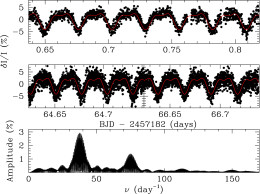In the wake of the recent media attention over an enigmatic, dimming star, another intriguing object has been discovered: J1529+2928, a white dwarf that periodically dims. This mystery, however, may have a simple solution — with interesting consequences for future surveys of white dwarfs.
Unexpected Variability
J1529+2928 is an isolated white dwarf that appears to have a mass of slightly more than the Sun. But rather than radiating steadily, J1529+2928 dims once every 38 minutes — almost as though it were being eclipsed.
The team that discovered these variations, led by Mukremin Kilic (University of Oklahoma), used telescopes at the Apache Point Observatory and the McDonald Observatory to obtain follow-up photometric data of J1529+2928 spread across 66 days. The team also took spectra of the white dwarf with the Gemini North telescope.
Kilic and collaborators then began, one by one, to rule out possible causes of this object’s variability.
Eliminating Options
- The period of the variability is too long for J1529+2928 to be a pulsating white dwarf with luminosity variation caused by gravity-wave pulsations.
- The variability can’t be due to an eclipse by a stellar or brown-dwarf companion, because there isn’t any variation in J1529+2928’s radial velocity.
- It’s not due to the orbit of a solid-body planetary object; such a transit would be too short to explain observations.
- It can’t be due to the orbit of a disintegrated planet; this wouldn’t explain the light curves observed in different filters — plus the light curve doesn’t change over the 66-day span.
Spotty Surface

Top and middle two panels: light curves from three different nights observing J1529+2928’s periodic dimming. Bottom panel: The Fourier transform shows a peak at 37.7 cycles/day (and another, smaller peak at its first harmonic). [Kilic et al. 2015]
The formation of such a starspot would almost certainly require the presence of magnetic fields. Interestingly, J1529+2928 doesn’t have a strong magnetic field; from its spectra, the team can constrain its field strength to be less than 70 kG.
Given that up to 15% of white dwarfs are thought to have kG magnetic fields, eclipse-like events such as this one might in fact be common for white dwarfs. If so, then many similar events will likely be observed with future surveys of transients — like Kepler’s ongoing K2 mission, which is expected to image another several hundred white dwarfs, or the upcoming Large Synoptic Survey Telescope, which will image 13 million white dwarfs.
Citation
Mukremin Kilic et al 2015 ApJ 814 L31. doi:10.1088/2041-8205/814/2/L31

1 Comment
Pingback: another star with "mysterious" dimming